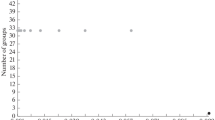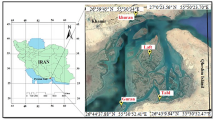Abstract
The downstream section of the Jinsha River is a global biodiversity hotspot for fishes. However, cascade hydropower development has altered the original habitat and has had a huge impact on the area’s fish diversity. To assess the power of DNA barcoding and construct a DNA barcode library for Xiangjiaba reservoir area, 333 fish mitochondrial DNA barcodes (672 bp) employing a fragment of the mitochondrial cytochrome c oxidase subunit I gene (COI) were obtained for 57 species from the Xiangjiaba reservoir area in this study. The intra-specific genetic distances were below 2%, ranging from 0 to 1.69% (mean 0.19%). The interspecific genetic distances within genera ranged from 0.45 to 11.14% (mean 2.98%). The Bayesian inference (BI) tree and neighbor-joining (NJ) tree inferred that all species were unambiguously separated, with strong support values at the terminal branches except the node of Hemibarbus maculatus shared with its adjacent clade. The DNA barcoding gaps could accomplish fish species discrimination. These results revealed that DNA barcoding was an effective tool for the identification of fish species, and that it was possible to construct a robust DNA barcode reference library for fish species in the Xiangjiaba reservoir area. The results will contribute to future efforts in monitoring, conservation, and management of fish resources.



Similar content being viewed by others
References
Aquilino SV, Tango JM, Fontanilla IK, Pagulayan RC, Basiao ZU, Ong PS, Quilang JP (2011) DNA barcoding of the ichthyofauna of taal Lake Philippines. MolEcolResour 11:612–619. https://doi.org/10.1111/j.1755-0998.2011.03000.x
Chen YF, Chen YY, He DK (2002) Biodiversity in the yangtze river fauna and distribution of fishes. J Ichthyol 42:161–171
Chen WT, Ma XH, Shen YJ, Mao YT, He SP (2015) The fish diversity in the upper reaches of the salween river Nujiang River, revealed by DNA barcoding. Sci Rep 5:17437. https://doi.org/10.1038/srep17437
Cheng JL, Lopez JA, Zhang E (2009) Pseudobagrus fui Miao, a valid bagrid species from the Yangtze river drainage, South China (teleostei: bagridae). Zootaxa 2072(1):56–68. https://doi.org/10.11646/zootaxa.2072.1.3
Costa FO, Dewaard JR, Boutillier J, Ratnasingham S, Dooh RT, Hajibabaei M, Hebert PD (2007) Biological identifications through DNA barcodes: the case of the Crustacea. Can J Fish Aquat Sci 64:272–295
Ding RH (1994) The fishes of Sichuan China. Sichuan Publishing House of Science and Technology, Chengdu
Dudgeon D (2011) Asian river fishes in the anthropocene: threats and conservation challenges in an era of rapid environmental change. J Fish Biol 79:1487–1524. https://doi.org/10.1111/j.1095-8649.2011.03086.x
Edgar RC (2004) MUSCLE: multiple sequence alignment with high accuracy and high throughput. Nucleic Acids Res 32:1792–1797. https://doi.org/10.1093/nar/gkh340
Esguicero ALH, Arcifa M (2010) Fragmentation of a Neotropical migratory fish population by a century-old dam. Hydrobiologia 638:41–53. https://doi.org/10.1007/s10750-009-0008-2
Ewert MA, Lang JW, Nelson CE (2005) Geographic variation in the pattern of temperature-dependent sex determination in the American snapping turtle (chelydra serpentina). J Zool 265:81–95. https://doi.org/10.1017/S0952836904006120
Feng C et al (2019) Molecular systematics of the triplophysa robusta (cobitoidea) complex: extensive gene flow in a depauperate lineage. Mol Phylogenet Evol 132:275–283
Froese R, Pauly D (2019) FishBase. World Wide Web electronic publication.www.fishbase.org. Accessed 12 Feb 2019
Gao SB, Tang HY, Qiao Y, Yang Z, Chen JS (2013) Status of fishery resources in the mainstream of the lower reaches of Jinsha River. J Hydroecol 34:44–49
Gutierrez-Gutierrez C, Cantalapiedra-Navarrete C, Montes-Borrego M, Palomares-Rius JE, Castillo P (2013) Molecular phylogeny of the nematode genus Longidorus (nematoda: longidoridae) with description of three new species. Zool J Linn Soc 167:473–500. https://doi.org/10.1111/zoj.12019
He CL, Song ZB, Zhang E (2011) Triplophysa fishes in China and the status of its taxonomic studies Sichuan. J Zool 30:150–155
Hebert PDN, Gregory TR (2005) The promise of DNA barcoding for taxonomy. Syst Biol 54:852–859. https://doi.org/10.1080/10635150500354886
Hebert PDN, Cywinska A, Ball SL, DeWaard JR (2003) Biological identifications through DNA barcodes. Proc R Soc B 270:313–321. https://doi.org/10.1098/rspb.2002.2218
Hebert PDN, Stoeckle MY, Zemlak TS, Francis CM (2004) Identification of birds through DNA barcodes. PLoSBiol 2:1657–1663. https://doi.org/10.1371/journal.pbio.0020312
Huelsenbeck JP, Ronquist F (2001) MRBAYES: Bayesian inference of phylogenetic trees. Bioinformatics 17:754–755
Knebelsberger T et al (2014) A reliable DNA barcode reference library for the identification of the North European shelf fish fauna. MolEcolResour 14:1060–1071. https://doi.org/10.1111/1755-0998.12238
Kottelat M (2013) The fishes of the inland waters of Southeast Asia: a catalogue and core bibliography of the fishes known to occur in freshwaters, mangroves and estuaries. Raffles Bull Zool 27:1–663
Lakra WS et al (2011) DNA barcoding Indian marine fishes. MolEcolResour 11:60–71. https://doi.org/10.1111/j.1755-0998.2010.02894.x
Li T, Tang L, Wang L, An L, Wang J, Mo KL, Chen QW (2020) Distribution characteristics and ecological types changes in fish communities under hydropower development from Xiluodu to Xiangjiaba reach. Acta Ecol Sin 40:1473–1485
Librado P, Rozas J (2009) DnaSP v5: a software for comprehensive analysis of DNA polymorphism data. Bioinformatics 25:1451–1452. https://doi.org/10.1093/bioinformatics/btp187
Lin PC, Miao ZG, Gao X, Liu HZ (2015) Length-weight relationships of 11 fish species from the upper Jinsha River, China. J ApplIchthyol 31:223–224. https://doi.org/10.1111/jai.12466
Liu HJ, Lan HX, Liu Y, Zhou Y (2011) Characteristics of spatial distribution of debris flow and the effect of their sediment yield in main downstream of Jinsha River, China. Environ Earth Sci 64:1653–1666. https://doi.org/10.1007/s12665-009-0409-6
Liu SW, Zhang XF, Lv PY, Lan F (2019) Effects of cascade reservoirs in the lower reaches of Jinsha River on nitrogen and phosphorus retention. J Lake Sci 31:656–666
McCusker MR, Denti D, Van Guelpen L, Kenchington E, Bentzen P (2013) Barcoding Atlantic Canada’s commonly encountered marine fishes. MolEcolResour 13:177–188. https://doi.org/10.1111/1755-0998.12043
Nelson JS, Grande TC, Wilson MVH (2016) Fishes of the world. John Wiley & Sons, Hoboken
Packer L, Gibbs J, Sheffield C, Hanner R (2009) DNA barcoding and the mediocrity of morphology. MolEcolResour 9:42–50. https://doi.org/10.1111/j.1755-0998.2009.02631.x
Pecnikar ZF, Buzan EV (2014) 20 years since the introduction of DNA barcoding: from theory to application. J Appl Genet 55:43–52. https://doi.org/10.1007/s13353-013-0180-y
Prokofiev AM (2010) Morphological classification of loaches (Nemacheilinae). J Ichthyol 50:827–913
Rambaut A, Suchard MA, Xie D, Drummond AJ (2014) Tracer v1.6. http://beast.bio.ed.ac.uk/Tracer
Ronquist F et al (2012) MrBayes 3.2: efficient bayesian phylogenetic inference and model choice across a large model space. System Biol 61:539–542. https://doi.org/10.1093/sysbio/sys029
Roskam JC, Brakefield PM (1999) Seasonal polyphenism in Bicyclus (Lepidoptera : Satyridae) butterflies: different climates need different cues. Biol J Linn Soc 66:345–356. https://doi.org/10.1006/bijl.1998.0268
Rosso JJ, Mabragaña E, Castro MG, de Astarloa JM (2012) DNA barcoding Neotropical fishes: recent advances from the Pampa Plain, Argentina. MolEcolResour 12:999–1011
Sambrook J, Russell DW (2001) Molecular cloning: a laboratory manual, 3rd edn. Cold Spring Harbor Laboratory Press, New York
Shen YJ, Guan LH, Wang DQ, Gan XN (2016) DNA barcoding and evaluation of genetic diversity in Cyprinidae fish in the midstream of the Yangtze River. EcolEvol 6:2702–2713. https://doi.org/10.1002/ece3.2060
Shen YJ, Hubert N, Huang Y, Wang XZ, Gan XN, Peng ZG, He SP (2019) DNA barcoding the ichthyofauna of the Yangtze River: insights from the molecular inventory of a mega-diverse temperate fauna. MolEcolResour 19:1278–1291. https://doi.org/10.1111/1755-0998.12961
Sun LY, Wei QW, Hui Z, Wang CY, Hao D, Xiao X (2014) Surveys on spatial distribution of fishes based on hydroacoustics from Xiangjiaba Dam to Yibin reach of the Upper Yangtze River. Freshw Fish 44:53–58
Tamura K, Peterson D, Peterson N, Stecher G, Nei M, Kumar S (2011) MEGA5: molecular evolutionary genetics analysis using maximum likelihood, evolutionary distance, and maximum parsimony methods. MolBiolEvol 28:2731–2739. https://doi.org/10.1093/molbev/msr121
Trivedi S, Aloufi AA, Ansari AA, Ghosh SK (2016) Role of DNA barcoding in marine biodiversity assessment and conservation: an update. Saudi J BiolSci 23:161–171. https://doi.org/10.1016/j.sjbs.2015.01.001
Wang LJ, Wu ZH, Liu MX, Liu W, Zhao WX, Liu HJ, You F (2018) DNA barcoding of marine fish species from Rongcheng Bay, China. PeerJ 6:e5013. https://doi.org/10.7717/peerj.5013
Ward RD (2009) DNA barcode divergence among species and genera of birds and fishes. MolEcolResour 9:1077–1085. https://doi.org/10.1111/j.1755-0998.2009.02541.x
Ward RD, Zemlak TS, Innes BH, Last PR, Hebert PD (2005) DNA barcoding Australia’s fish species. Philos Trans R SocLondSer B 360:1847–1857. https://doi.org/10.1098/rstb.2005.1716
Wu XW (1977) The cyprinid fishes of China. Technical Printing House, Shanghai
Wu YF, Wu CZ (1992) The fishes of the Qinghai-Xizang Plateau. Sichuan Publishing House of Science and Technology, Sichuan
Xie P (2003) Three-Gorges Dam: risk to ancient fish. Science 302:1149–1150. https://doi.org/10.1126/science.302.5648.1149b
Xie SG, Li ZJ, Liu JS, Xie SQ, Wang HZ, Murphy BR (2007) Fisheries of the Yangtze river show immediate impacts of the three gorges dam. Fisheries 32:343–344
Zeng Q ( 2013) Molecular phylogeny and divergence time estimation of the bagrid catfishes (Actinopterygii: Siluriformes). Southwest University
Zou R, Liang C, Dai MM, Wang XD, Zhang XY, Song ZB (2020) DNA barcoding and phylogenetic analysis of bagrid catfish in China based on mitochondrial COI gene . Mitochondrial DNA A 31:73–80. https://doi.org/10.1080/24701394.2020.1735379
Acknowledgements
This work was supported by grants from the National Natural Science Foundation of China (31702016) to Y. W., from the National Natural Science Foundation of China (51779105) to F. X. and from the National Natural Science Foundation of China (51979123) to H. L. We thank Innovative Research Team Foundation of the Department of Education of Hubei Province, China (T2020034). We also thank LetPub (www.letpub.com) for its linguistic assistance during the preparation of this manuscript.
Author information
Authors and Affiliations
Contributions
FX and YW conceived and designed the research. FX, HW and DZ collected the samples. YW performed computational analyses. YW draft the paper. FX and HL revised the paper.
Corresponding author
Ethics declarations
Conflict of interest
The authors report no conflict of interest. The authors alone are responsible for the content and writing of the paper.
Additional information
Publisher's Note
Springer Nature remains neutral with regard to jurisdictional claims in published maps and institutional affiliations.
Supplementary Information
Below is the link to the electronic supplementary material.
Rights and permissions
About this article
Cite this article
Wang, Y., Wen, H., Zhai, D. et al. DNA barcoding for identification of fishes in Xiangjiaba reservoir area in the downstream section of the Jinsha river. Conservation Genet Resour 13, 201–208 (2021). https://doi.org/10.1007/s12686-021-01196-6
Received:
Accepted:
Published:
Issue Date:
DOI: https://doi.org/10.1007/s12686-021-01196-6




